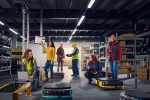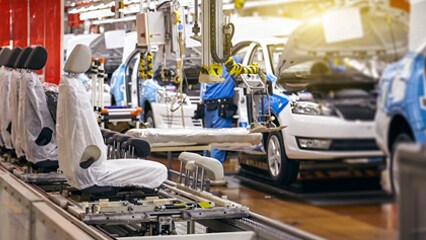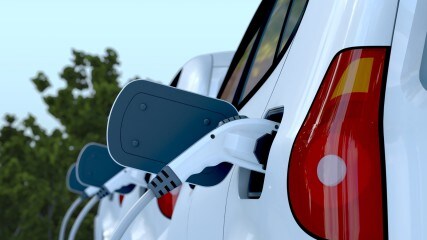
Challenges
The industry, OEMs, suppliers enter historic era of transformation
Pressures to transform — and invest — place industry at a crossroads. The auto industry is undergoing its largest transformation since the invention of the assembly line 100 years ago. The principal drivers of this new era are the regulatory and customer trends supporting the accelerated development and adoption of electric vehicles (EVs) and CASE (connected, automated, shared, electrified) technologies.
The last two years have added pressure on protecting margins for the industry. Supply chain disruptions, recent spiking inflation, and rising wages as well as the effects of sanctions on Russia are converging to raise the costs and limit the availability of raw materials and intermediary inputs such as electronics and microprocessors.
A tale of two business models? We believe the industry is at an important crossroads. Original equipment manufacturers (OEMs) will need to accelerate the development of a new EV business while simultaneously running the legacy internal combustion engine (ICE) business. To achieve this business-model duality, OEMs will need to make dramatic changes and fundamentally reshape their business models, configurations, capabilities, cloud and data, and corporate culture.
Indeed, there’s much at stake for both OEMs and their suppliers. According to a PwC analysis, the value pool in the mobility ecosystem (both traditional ICE vehicles and new CASE technology-based mobility) is poised to grow from about $3 trillion today to $6.5 trillion in 2030.
EVs, CASE tech to gain traction through 2035
Demand for non-ICE vehicles through 2035 appears promising. According to a PwC analysis, EV adoption rates in the US will rise from 2% currently to 44% by 2035, with rates in the EU and China to accelerate even faster. PwC believes that advanced automated vehicles (L3, L4 and L5), however, will inch up to about 16% of all new LV sales in the US by 2035. These expectations are comparatively conservative and assume EVs will achieve total cost-of-ownership parity with ICE vehicles by 2025, as well as assumptions on EV-charging infrastructure development forecasts.
We expect the following to drive the adoption: consumer preferences and expectations; increasing data privacy and security regulation; policies supporting the electrification (and decarbonization) of transportation; and the development of a national EV-charging ecosystem.
Accelerating out of the low-returns lane?
According to a PwC analysis, the auto industry has experienced diminishing returns on invested capital, with rates averaging about 5.4% over the 2017-2021 period for OEMs and about 8.7% for suppliers. Profits for OEMs have also slipped – from 6.7% in 2017 to 3.4% in 2021. This has contributed to underwhelming shareholder value over the last decade – a 199% return for OEMs and 298% return for suppliers – compared to 529% for the S&P 500 over the same period. As OEMs build out CASE-oriented businesses, they may well experience continued pressure on returns in the short term before those returns can potentially improve and usher back in a period of value to the industry.
Addressing the challenges
To meet the depth and breadth of challenges surrounding performance improvement and the need to transform, the auto industry will likely need to pull many levers. This may mean strengthening their traditional legacy business models while, on parallel tracks, developing altogether new ones.
Here, we propose four critical areas the industry can address to help manage current and future challenges. The four main spheres to address: capabilities, configuration, cloud and data-based technology, and culture.
Key questions for automotive players
- Configuration: What is the effective business architecture and operating model to deliver unique customer value? How do we enhance the core business to invest in the new business?
- Capabilities: What are the new ways to play and what capabilities are required to deliver unique customer value?
- Cloud and data: What is the leading way to create an ecosystem of privileged customer insights and differentiating customer experiences?
- Culture: How do we go about creating the culture, processes and metrics that matter for the new business vs. the core business?

4Cs: Configuration, Capabilities, Cloud and Culture
Configuration
Building new CASE business models alongside legacy core business
Building a new operating model that supports new businesses. Auto OEMs — as well as many of their Tier 1 and even Tier 2 suppliers — will likely need to reorganize and broaden their traditional operating model to accommodate new business-creating products and services, and attract the emerging skills of the workforce. Naturally, auto OEMs will continue to focus on their core business (i.e., vehicles, aftermarket maintenance and repair, and financial services attached to those vehicles) largely built upon product and industrial platforms.
Yet, as OEMs begin to bolt on new businesses — namely mobility and connected services as well as commercial fleets — to their core business, they may likely need to create an operating model that incorporates those businesses and the software, technology and service platforms they are built upon.
Once the operating model architecture is clear, companies should examine which cross-functional capabilities are required to support the new model (i.e., Industry 4.0, digital and cloud, data analytics and insights, new data-driven business models, etc.).
An enhanced legacy business to fuel the growth of new ones. Such a foundational reconfiguration of the traditional operating model will likely look different from company to company and may be carried out at different paces. However, what is clear is that building one out should be driven by the optimization of the core business in order to fund the development of new businesses.
As an example of innovative reconfigurations, Ford Motor Company in March announced plans to reorganize and create distinct auto units for its ICE vehicle business (to be called Ford Blue) and their EV vehicle business (Ford Model e). Ford has also created separate business units for Ford Next to focus on autonomous vehicles, mobility services and new technologies, and Ford Pro, which focuses on commercial vehicles and services. These moves suggest the auto giant is reorganizing to accelerate innovation within its legacy corporate structure and better position itself to compete against both new EV competitors and legacy automakers. Getting more out of the legacy business means enhancing and transforming on numerous fronts, including research and development, SG&A (selling, general and administrative) and business services, operations and retail customer experience. By improving the business agility, performance and margins in these areas, OEMs will likely be better positioned to invest in a growing number of new business opportunities, from EV charging services to vehicle-to-everything (V2X) connectivity services to commercial fleet services.
Capabilities
New ways to play may require a whole new set of capabilities
Increasingly, auto OEMs may need to keep their focus on two lanes: their traditional business, and on entering new businesses. However, the capabilities and skilled talent needed for one may not be sufficient for the other.
As CASE technologies grow, so, too, have the number of new entrants in the mobility ecosystem. The question for auto OEMs is whether they can keep pace with the opportunities and find ways to become players in the newly hatched sub-sector of digital mobility services. Can they quickly participate in the new ways to play with existing capabilities, or will they need to acquire those capabilities — either through in-house upskilling or, more likely, through partnerships with or acquisition of tech players in areas such as cloud platform, digital service providers, customer experience technology and smart mobility technology?
The $6.5 trillion question. There’s much at stake for OEMs that can make their legacy businesses more profitable to help build out new businesses. PwC expects that legacy and new business opportunities opening to the auto industry will total about $6.5 trillion by 2030, up from about $3 trillion currently. This growth is premised upon a fundamental reshaping of the industry as it moves away from a world heavily dominated by ICE vehicles and enters one dominated by CASE technologies.
We expect the traditional automotive products and services (ICE powertrains, financing and insurance, etc.) market to continue to be highly relevant and expect it will account for $2.5 trillion of the total industry value pool of $6.5 trillion by 2030. Other emerging value pools stand to grow much more quickly. For example, we expect new products and services (i.e., advanced driver assistance systems L2-L5 technology, battery-powered electric vehicles and charging services and infrastructure) to experience a 23% compound annual growth rate (CAGR) through 2030, representing a $2.5 trillion value pool. Likewise, we expect digital services (V2X connectivity, e-commerce, usage-based insurance, etc.) to grow by 22% over the same period to $1.3 trillion. New business models (automated vehicles, smart mobility and commercial fleet services) will grow at an 18% CAGR, we believe, to $285 billion over the same period.
Beyond digital capabilities. OEMs can transform themselves from the inside to drive growth and profitability. For example, according to PwC analysis, companies can reduce operating costs by 5% to 40% through smart factory transformations (i.e., Industry 4.0 technology enablement, value at scale). Additionally, connected supply chains can yield reductions of up to 30% in material costs via adopting source-to-pay technologies and processes and can improve customer service and cut down on inventory stuck in warehouses by as much as 40%.
How tax leadership can help
While auto OEMs and their suppliers develop their new CASE-predicated businesses, they will likely enlist tax leaders to help guide C-suite decisions surrounding that transformation. For instance, CIOs, charged with advancing adoption of Industry 4.0 technologies, developing carbon emissions ledgers and supply-chain control towers, will likely need to work closely with their tax counterparts to actualize such initiatives. To some extent, tax leadership has played an underwhelming role in the digital transformation conversation. In fact, in a January survey, just 30% of CIOs said their company’s tax leaders were part of the planning process for digital initiatives.
We expect the tax-tech connection will likely become much tighter for the auto industry in order to help capture maximum value from the value pools we see expanding in the next decade within the industry. Making prudent decisions surrounding digital investments through a tax lens may become more and more important — whether they impact large-scale transformations, enterprise resource planning (ERP) and cloud modernization, or even environmental, social and governance (ESG) reporting or emerging tech pilots. Tax considerations can also include research and development (R&D) credits, incentives and intellectual property management.
Cloud and data
Working with tech players key to new cloud-based products and services
CASE technologies continue to advance and are being led by a growing corps of cloud tech players entering the mobility value chain — not only as increasingly important and numerous upstream suppliers, but also in downstream markets. The movement of these tech companies into the automotive sector is introducing a growing potential for auto OEMs to benefit. However, in most cases, becoming a beneficiary of new cloud-based services and products likely means forging relationships with the new entrants.
Through such relationships, OEMs will likely continue to develop multi-cloud strategies to create new digital services, new revenue streams, operational effectiveness and accelerate speed-to-value. We see four main cloud strategies playing out now that will likely continue to become increasingly critical to auto OEMs’ growth in new businesses: marketing cloud, industrial cloud, vehicle cloud and back-office cloud (detailed below).
Culture
Create agile and innovative cultures to drive the transformation
As OEMs design new operating models and work with (or acquire) new technology entrants and skilled talent, the corporate culture may inevitably need to change as well. In fact, a larger culture shift is likely needed to carry out a transformation that means aligning and supporting new operating models, new business strategies and a redefined workforce.
One of the biggest changes is a greater need for digital and data science and analytics skills, as well as skills to oversee new automation technology. A modernized talent strategy and upskilling can achieve only so much.
Companies may increasingly need to change their culture significantly to prepare their employees for new skills and ways of working — and, perhaps just as important, to attract talent that already possesses such skills.
As OEMs carve out new businesses within their organizations, they should consider using the “skunkworks” or “venture capital startup” models that are well-funded, to encourage small teams and reward innovation. Bosch, for instance, formed a “Bosch Digital” unit to grow their Industry 4.0 business and to forge relationships with automotive and industrial manufacturers. Another example is Ford’s plans to separate the EV- and ICE-vehicle businesses (mentioned earlier). Such moves can alter the company culture by demonstrating a willingness to create pockets of innovation and, to a degree, independence from large, legacy organizations. This can lead to improved recruitment, as new talent discovers it’s possible to work like a nimble employee in a startup while within a traditional corporate culture. In fact, some OEMs are actively pursuing technology talent from Silicon Valley via innovation and technology scouting units.
ESG acceleration: a historic shift in corporate strategy… and culture. The momentous societal push for cleaner transportation through the electrification of transportation — the largest source of greenhouse gas emissions in the US at about 30% of the nation’s total — figures prominently in our EV adoption forecasts. But achieving ESG excellence will likely require going much further than building a new business around EVs. A purpose-driven commitment to cleaner production of cleaner vehicles marks a profound transformation for the industry. It may also mean OEMs taking enterprise-wide inventory of the sources of their emissions via the establishment of a carbon ledger that builds in verifiable emissions — not only Scope 1 but, perhaps more important, also Scopes 2 and 3. Additionally, lowering emissions can lead to OEMs becoming more discriminating about their suppliers’ emissions as well, and monitoring their verifiable carbon footprint — especially stemming from high-emission raw material inputs including steel and aluminum, petrochemicals and glass, as well as finished products such as electronics components.
Aspiring to succeed on these fronts is not just a business strategy. It’s mostly about evolving the culture and motivating existing workers — and enlisting new ones — who are on board and engaged with ESG initiatives affecting the global automotive ecosystem. It’s building a culture throughout the business that searches — and is rewarded — for innovations that drive sustainability in business, as well as in rallying behind good governance and diversity and inclusiveness in the workforce.
Next steps
Looking ahead, we see five overarching imperatives auto OEMs and their supplier networks should focus on now to help successfully capture future value pools, while improving margins and shareholder value.
This is the first in a series of PwC articles on how automotive players can successfully navigate in the rapidly changing landscape. Future articles will explore these imperatives in more detail.

There are five key imperatives for auto companies to create new value in the emerging auto and mobility environment
- Reimagine your place in the world
- Transform the legacy business
- Embrace and create value
- Rewire your organization's DNA
- Reinvent your social contract
Reimagine your place in the world
Redefine what significant problems your company is here to solve and what differentiating capabilities you will need to build to deliver on that promise.
Transform the legacy business
Manage the legacy auto business more efficiently to boost profits and reinvest the enhanced cashflows to adopt new modern and advanced business opportunities, e.g., BEV, autonomous cars, etc.
Embrace and create value
Collaborate to deliver value propositions that no company could offer by itself. Focus on what you do best and combine that with the capabilities, speed, and scale your ecosystems enable to generate greater value for all participants.
Rewire your organization's DNA
Revolutionize ways of working for everyone from leadership to the last mile teams. Encourage moving away from legacy slow-moving culture to an agile one. Promote company-wide upskilling drives to enable and deliver new differentiated capabilities, e.g., smart factories, blockchain based finance systems, etc.
Reinvent your social contract
Help employees rediscover their value in a world of automation and guide them towards the means to take leadership. Create a system of engagement focused on purpose, agile contributions, sense of community and rewards beyond pay.



















